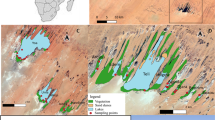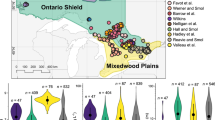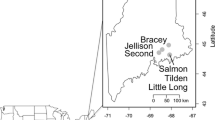Abstract
Diatoms were identified and enumerated from the surface sediments of 111 lakes, 45 from the Kamloops region and 66 from the Cariboo/Chilcotin region, located on the southern Interior Plateau of British Columbia, Canada. This paper is an extension of another study which investigated the relationship of diatoms to salinity and ionic composition in 65 lakes from the Cariboo/Chilcotin region. The 111 lakes spanned a large gradient in salinity, ranging from fresh through hypersaline (late-summer salinity values ranged from 0.04 to 369 g l−1), and included both carbonate- and sulphate-dominated lakes with sodium and magnesium as the dominant cations. The Kamloops region had more sulphate-dominated, hypersaline lakes and fewer carbonate-rich lakes than the Cariboo/Chilcotin region. Most lakes had higher salinities in the late-summer compared to the spring.
Both salinity and brine-type were important variables that could explain the different diatom assemblages present in the lakes. The majority of diatom taxa had salinity optima in the freshwater to subsaline range (<3 g l−1), and the taxa displayed a range of both narrow and broad tolerances along the salinity gradient. Weighted-averaging regression and calibration, and maximum likelihood techniques were used to develop salinity inference models from the diatom assemblages based on their relationship to the spring, late-summer and average lakewater salinity measurements. Simple weighted-averaging (WA) models generally produced the same or lower bootstrapped RMSEs of prediction than weighted-averaging with tolerance downweighting (WA(tol)) in the two regional and the combined datasets. Weighted averaging partial least squares (WA-PLS) showed little or no improvement in the predictive abilities of the datasets, as judged by the jackknifed RMSE of prediction. In all cases, the combined dataset of 102 lakes performed better than either of the smaller regional datasets, with relatively little difference between spring, average and late-summer salinity models. The maximum likelihood models gave lower apparent RMSEs of prediction in comparison to other methods; however, independent validation of this technique using methods such as bootstrapping were not undertaken because of the computer intensive nature of such analyses. These diatom-based salinity models are now available for reconstructing salinity and climatic trends from appropriately chosen closed-basin lakes in the Interior region of British Columbia.
Similar content being viewed by others
References
American Public Health Association, 1980. Standard Methods for the Examination of Water and Wastewater, 15th Edition, Washington, D.C.
Atmospheric Environment Service. Canadian Climate Normals: temperature and precipitation 1951–1980, British Columbia. Canadian Climate Program.
Birks, H. J. B., S. Juggins & J. M. Line, 1990a. Lake surfacewater chemistry reconstructions from palaeolimnological data.In B. J. Mason (ed.), The Surface Waters Acidification Programme. Cambridge University Press, Cambridge pp. 301–313.
Birks, H. J. B., J. M. Line, S. Juggins, A. C. Stevenson & C. J. F. ter Braak, 1990b. Diatoms and pH reconstruction. Phil. Trans. r. Soc., Lond. B 327: 263–278.
Blinn, D. W., 1993. Diatom community structure along physicochemical gradients in saline lakes. Ecology 74: 1246–1263.
Camburn, K. E., J. C. Kingston & D. F. Charles (eds), 1984–86. PIRLA Diatom Iconograph. Report No. 3, PIRLA Unpublished Report Series, 53 photographic plates, 1059 figures. Dept. of Biology, Indiana Univ., Bloomington, IN.
Campbell, C. E. & E. E. Prepas, 1986. Evaluation of factors related to the unusually low chlorophyll levels in prairie saline lakes. Can. J. Fish. aquat. Sci. 43: 846–854.
Cumming, B. F. & J. P. Smol, 1993. Development of diatom-based models for paleoclimatic research from lakes in British Columbia (Canada). Hydrobiologia 269/270: 179–196.
Cumming, B. F., J. P. Smol & H. J. B. Birks, 1992. Scaled chrysophytes (Chrysophyceae and Synurophyceae) from Adirondack drainage lakes and their relationship to measured environmental variables. J. Phycol. 28: 162–178.
Cumming, B. F., S. E. Wilson & J. P. Smol, 1993. Paleolimnological potential of chrysophyte cysts and scales and of sponge spicules as indicators of lake salinity. Int. J. Salt Lake Res. 2: 87–92.
Cumming, B. F., S. E. Wilson, R. I. Hall & J. P. Smol, in press. Diatoms from British Columbia (Canada) Lakes and their Relationship to Salinity, Nutrients, and Other Limnological Variables. Bibliotheca Diatomologica. 207 pp.
Dixit, S. S., J. P. Smol, J. C. Kingston & D. F. Charles, 1992. Diatoms: powerful indicators of environmental change. Envir. Sci. Technol. 26: 22–32.
Farley, A. L., 1979. Atlas of British Columbia: People, environment, and resource use. University of British Columbia Press, Vancouver, 136 pp.
Fritz, S. C., 1990. Twentieth-century salinity and water-level fluctuations in Devils Lake, North Dakota: Test of a diatom-based transfer function. Limnol. Oceanogr. 35: 1771–1781.
Fritz, S. C., S. Juggins & R. W. Battarbee, 1993. Diatom assemblages and ionic characterization of freshwater and saline lakes of the northern Great Plains, North America: a tool for reconstructing past salinity and climate fluctuations. Can. J. Fish. aquat. Sci. 50: 1844–1856.
Fritz, S. C., S. Juggins, R. W. Battarbee & D. R. Engstrom, 1991. Reconstruction of past changes in salinity and climate using a diatom-based transfer function. Nature 352: 706–708.
Gasse, F., J. F. Talling & P. Kilham, 1983. Diatom assemblages in East Africa: classification, distribution, and ecology. Revue Hydrobiol. trop. 16: 3–34.
Gasse, F., J. C. Fontes, J. C. Plaziat, P. Carbonel, I. Kaezmarska, P. De Deckker, I. Soulié-Marsche, Y. Callot & P. A. Dupeuble, 1987. Biological remains, geochemistry and stable isotopes for the reconstruction of environmental and hydrological changes in the Holocene lakes from North Sahara. Palaeogeogr. Palaeoclimatol. Palaeoecol. 60: 1–46.
Gell, P. A. & Gasse, F., 1994. Relationships between salinity and diatom flora from some Australian saline lakes. Proceedings of the 11th International Diatom Symposium, San Francisco, August 1990.
Glew, J. R., 1991. Miniature gravity corer for recovering short sediment cores. J. Paleolimnol. 5: 285–287.
Håkansson, H. & E. F. Stoermer, 1984. Observations on the type material ofStephanodiscus hantzschii Grunow in Cleve & Grunow. Nova Hedwigia 39: 477–495.
Hall, R. I. & J. P. Smol, 1992. A weighted-averaging regression and calibration model for inferring total phosphorus concentration from diatoms in British Columbia (Canada) lakes. Freshwat. Biol. 27: 417–434.
Hammer, U. T., 1986. Saline Lake Ecosystems of the World. Dr W. Junk Publishers, Boston, 616 pp.
Hammer, U. T., J. Shamess & R. C. Haynes, 1983. The distribution and abundance of algae in saline lakes of Saskatchewan, Canada. Hydrobiologia 105: 1–26.
Hill, M. O., 1973. Diversity and evenness: a unifying notation and its consequences. Ecology 54: 427–432.
Hustedt, F., 1930–1966. Die Kieselalgen Deutschlands, Österreichs und der Schweiz.In Dr L. Rabenhorst's Kryptogamen-Flora von Deutschland, Österreich und der Schweiz, Band VII, Otto Koeltz Science Publishers, Koenigstein.
International Consortium for Salt Lake Research (ICSLR), 1991. New Paleolimnological Research on Canadian Saline Lakes: Paleoecological investigations of salinity, climatic, and environmental shifts (PISCES). Salinet Issue No. 5, Gleneagles Publishing, Adelaide, 111 pp.
Jeffery, D. A., 1989. Laboratory Quality Assurance Manual. Zenon Environmental Inc., 8577 Commerce Court, Burnaby, B.C., Canada V5A 4N5., 34 pp.
Juggins, S. & C. J. F. ter Braak, 1993. CALIBRATE —unpublished computer program, Environmental Change Research Centre, University College, London.
Krammer, K. & H. Lange-Bertalot, 1986. Bacillariophyceae. 1. Teil: Naviculaceae.In Süßwasserflora von Mitteleuropa, Band 2/1, 876 pp.
Krammer, K. & H. Lange-Bertalot, 1988. Bacillariophyceae. 2. Teil: Bacillariaceae, Epitherniaceae, Surirellaceae.In Süßwasserflora von Mitteleuropa, Band 2/2, 596 pp.
Krammer, K. & H. Lange-Bertalot, 1991. Bacillariophyceae. 3. Teil: Centrales, Fragilariaceae, Eunotiaceae.In Süßwasserflora von Mitteleuropa, Band 2/3, 576 pp.
Krammer, K. & H. Lange-Bertalot, 1991. Bacillariophyceae. 4. Teil: Achnanthaceae Kritische Ergänzungen zu Navicula (Lineolatae) und GomphonemaIn Süßwasserflora von Mitteleuropa, Band 2/4, 437 pp.
Last, W. M. & L. A. Slczak, 1988. The salt lakes of western Canada: a paleolimnological overview. Hydrobiologia 158: 301–316.
Line, J. M., C. J. F. ter Braak & H. J. B. Birks, 1994. WACALIB version 3.3 — a computer program to reconstruct environmental variables from fossil assemblages by weighted averaging and to derive sample-specific errors of prediction. J. Paleolimnol. 10: 147–152.
Oksanen, J., E. Läärä, P. Huttunen & J. Meriläinen, 1988. Estimation of pH optima and tolerances of diatoms in lake sediments by the methods of weighted averaging, least squares and maximum likelihood, and their use for the prediction of lake acidity. J. Paleolimnol. 1: 39–49.
Patrick, R. & C. Reimer, 1966. The diatoms of the United States exclusive of Alaska and Hawaii. Vol. 1. The Academy of Natural Sciences of Philadelphia, Philadelphia, Monograph 13: 1–668.
Patrick, R. & C. Reimer, 1975. The diatoms of the United States exclusive of Alaska and Hawaii. Vol. 2, Part 1. The Academy of Natural Sciences of Philadelphia, Philadelphia, Monograph 13: 1–213.
Radle, N., C. M. Keister & R. W. Battarbee, 1989. Diatom, pollen, and geochemical evidence for the palaeosalinity of Medicine Lake, S. Dakota, during the Late Wisconsin and early Holocene. J. Paleolimnol. 2: 159–172.
Renaut, R. W., 1990. Recent carbonate sedimentation and brine evolution in the saline lake basins of the Cariboo Plateau, British Columbia, Canada. Hydrobiologia 197: 67–81.
Renaut, R. W. & P. R. Long, 1989. Sedimentology of the saline lakes of the Cariboo Plateau, Interior British Columbia, Canada. Sediment. Geol. 64: 239–264.
Roux, M., S. Servant-Vildary & M. Servant, 1991. Inferred ionic composition and salinity of a Bolivian Quaternary lake, as estimated from fossil diatoms in the sediments. Hydrobiologia 210: 3–18.
Servant-Vildary, S. & M. Roux, 1990. Multivariate analysis of diatoms and water chemistry in Bolivian saline lakes. Hydrobiologia 197: 267–290.
Smol, J. P., 1983. Paleophycology of a high arctic lake near Cape Herschel, Ellesmere Island. Can. J. Bot. 61: 2195–2204.
Stoermer, E. F. & H. Håkansson, 1984.Stephanodiscus parvus: Validation of an enigmatic and widely misconstrued taxon. Nova Hedwigia 39: 497–511.
ter Braak, C. J. F., 1986. Canonical correspondence analysis: a new eigenvector technique for multivariate direct gradient analysis. Ecology 67: 1167–1178.
ter Braak, C. J. F., 1988. CANOCO — A FORTRAN program for canonical community ordination by [partial] [detrended] [canonical] correspondence analysis, principal components analysis, redundancy analysis (version 2.1). Agricultural Mathematics Group, The Netherlands. Technical Report LWA-88-02, Wageningen, 95 pp.
ter Braak, C. J. F., 1990. Update Notes: CANOCO version 3.10. Agricultural Mathematics Group, Wageningen, The Netherlands, 35 pp.
ter Braak, C. J. F. & S. Juggins, 1993. Weighted averaging partial least squares regression (WA-PLS): an improved method for reconstructing environmental variables from species assemblages. Hydrobiologia 269/270: 485–502.
ter Braak, C. J. F. & C. W. N. Looman, 1986. Weighted averaging, logistic regression and the Gaussian response model. Vegetatio 65: 3–11.
ter Braak, C. J. F. & H. van Dam, 1989. Inferring pH from diatoms: a comparison of old and new calibration methods. Hydrobiologia 178: 209–223.
ter Braak, C. J. F., S. Juggins, H. J. B. Birks & H. van der Voet, 1993. Weighted averaging partial least squares regression (WA-PLS): definition and comparison with other methods for species-environmental calibration. In G. P. Patil & C. R. Rao (eds.), Multivariate Environmental Statistics. Elsevier Science Publishers, Amsterdam: 519–553.
Topping, M. S. & G. G. Scudder, 1977. Some physical and chemical features of saline lakes in central British Columbia. Syesis 10: 145–166.
Valentine, K. W. G. & A. Schori, 1980. Soils of the Lac La Hache — Clinton area, British Columbia. Rep. B.C. Soil Surv. 25, 118 pp.
Author information
Authors and Affiliations
Additional information
This is the second in a series of papers published in this issue on the paleolimnology of arid regions. These papers were presented at the Sixth International Palaeolimnology Symposium held 19–21 April, 1993 at the Australian National University, Canberra, Australia. Dr A. R. Chivas served as guest editor for these papers.
Rights and permissions
About this article
Cite this article
Wilson, S.E., Cumming, B.F. & Smol, J.P. Diatom-salinity relationships in 111 lakes from the Interior Plateau of British Columbia, Canada: the development of diatom-based models for paleosalinity reconstructions. J Paleolimnol 12, 197–221 (1994). https://doi.org/10.1007/BF00678021
Received:
Revised:
Accepted:
Issue Date:
DOI: https://doi.org/10.1007/BF00678021




